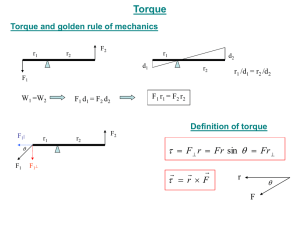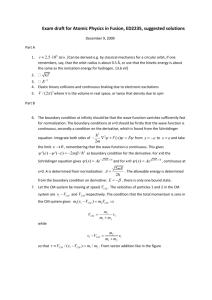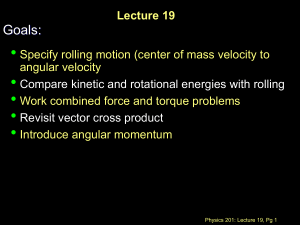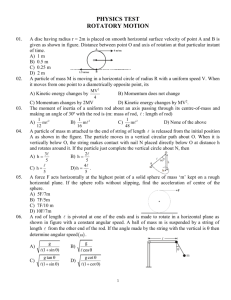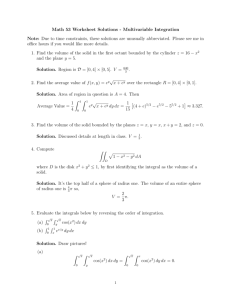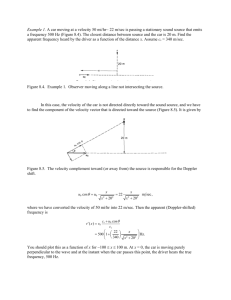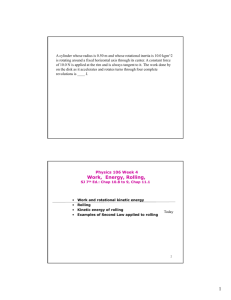ROTATIONAL KINETIC ENERGY
advertisement
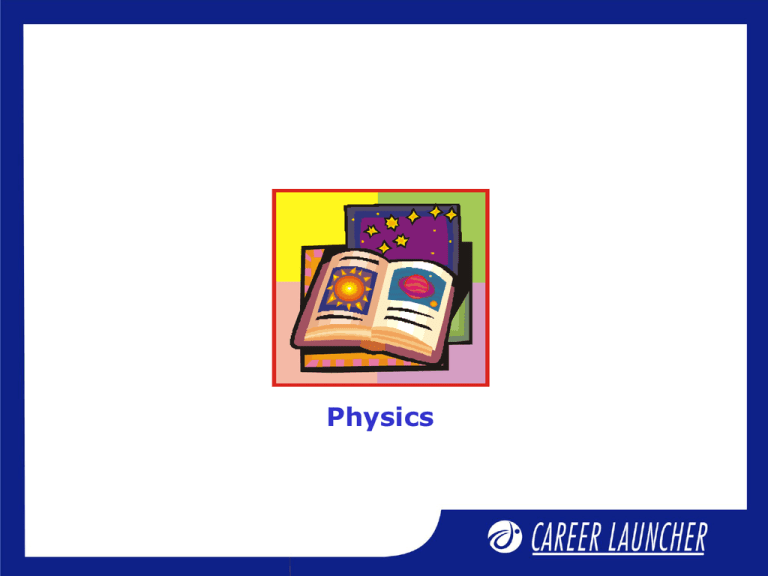
Physics Session Rotational Mechanics - 5 Session Objectives Session Objective 1. Rolling of a body – Description 2. Rolling of a body - Mathematical expression 3. Instantaneous center of rotation Rolling of a body Rolling without slipping : Motion is combined rotation and translation. There is no relative motion between body and surface P Q V surface Point of contact has no relative motion with surface Rolling of a body Friction (f) is responsible for rolling without slipping No work is done by f when body rolls without slipping P f=0 slipping 1 KE MV2 2 spinning no translation 1 2 KE I 2 f0 rolling 1 1 2 KE MV Icm2 2 2 Relationship between linear & angular velocity The point in contact with surface is momentarily at rest. Linear velocity is velocity of center of mass (o). Linear distance moved by centre of mass = S It is also the distance PQ along the edge of circular body P O r P r Vcm r S Q VCM Relationship between linear & angular velocity S r (r : radius of circular cross section) vCM ds d r r dt dt VCM r Dynamics of rolling Rolling without slipping = Linear motion of center of mass + circular motion about center of mass. VCM VCM VCM r + r r 2VCM O r VCM P V=0 Point P is at rest with respect to the surface at this instant. It is the instantaneous center of rotation . Kinetic Energy When considered with respect to P 1 KE Ip2 2 KE But Ip ICM Mr2 1 1 ICM2 MV2CM 2 2 ( vCM r ) Q r O ICM 1 2 vCM M 2 2 r VCM r rp P Kinetic Energy with respect to instantaneous axis of rotation Velocity vQ of the point Q, with respect to the instantaneous centre rotation vp vCM r rp and a p rp So torque (external) = I (I measured from P) KE 1 2 I and L I 2 are valid about instantaneous point of rotation. r Vp VCM O r rp P Class Test Class Exercise - 1 A disc, a ring and a sphere of same radius and same mass are placed on a rough horizontal table so that they can roll over the table. An equal impulsive force is imparted to each through their centres of mass and they start rolling and slipping. When the slipping stops the linear velocity is greatest for (a) ring (b) disc (c) sphere (d) All are equal Solution 1 2 1 2 1 2 I KE I mv v m 2 2 2 r2 Ring: I = mr2 1 2 KE v (2m) mvr 2 2 1 2 Disc : I mr 2 1 2 1 3 KE v m m mv d2 2 2 4 2 2 Sphere : I mr 5 1 2 2 7 KE v m m mv s2 2 5 10 For same mass and KE, sphere has maximum linear velocity. Hence, answer is (c). Class Exercise - 2 A solid sphere rolls on a horizontal plane without slipping, percentage of KE which is rotational is approximately (a) 28 (b) 3 (c) 72 (d) 100 Solution For a sphere, 1 2 1 I mv 2 2 2 1 2 2 2 2 mr mv 25 KE 1 mv 2 (0.4 1) 2 0.4 Rotational KE percentage 100% 1.4 28% Hence, answer is (a). Class Exercise - 3 A hoop of radius r rolls over a horizontal plane with constant velocity v without slipping. The velocity of any point t seconds after it passes the top position is vt (a) v cos r vt (c) 2v sin r vt (b) 2v cos r vt (d) 2v cos 2r v Solution is constant. A 2V B r C r – 2 v´ – 2 r´ P Speed at B = v’ v ' r ', v r v 1 cos r cos 2 Solution contd.. r ' r r cos r(1 cos cos(CPB) cos 2 2 r 1 2cos 1 2 2r cos 2 cos 2 2 t 2v cos 2 vt 2v cos 2r v ' 2r cos t Hence, answer is (d). Class Exercise - 4 A cord is wound round the circumference of a wheel of radius r. The axis of the wheel is horizontal and moment of inertia about its axis is I . A weight mg is attached to the end of the cord and falls from rest. After falling through a distance h, the angular velocity of the wheel will be 2gh (a) r mr (c) 2 mgh 2 2mr 2mgh (b) r 2 mr (d) 2gh Solution v = r Loss in PE = Gain in KE v m h m Solution contd.. 1 2 1 mgh Iwheel mv 2 2 2 1 v2 1 I mv 2 2 r2 2 2 1 I mr 2 2 1 I v m v 2 r2 2 r2 vr 2mgh I mr 2 Hence, answer is (b). Class Exercise - 5 A mass M is supported by a massless string wound round a uniform cylinder of mass M and radius R . On releasing the system from rest, the acceleration of mass M is (a) g (c) 2 g 3 (b) g 2 (d) depends on R R M Solution v = r R M Loss in PE = Gain in KE when M has dropped a height h. M Solution contd.. 1 2 1 2 Mgh Mv I 2 2 2 1 1 1 v Mv 2 Mr 2 2 22 r2 3 gh v 2 4 3v 2 h 4g 2 v 0 2ah v2 2 a g 2h 3 Hence, answer is (c). Class Exercise - 6 A ring and a cylinder of the same mass m and the same radius R are released with the same velocity at the same time on a flat horizontal surface such that they start rolling immediately on release towards a wall equidistant from both. The rolling friction is finite. Which of the two will reach the wall first? Solution For rolling, KE 1 1 mv2 I2 2 2 [v = r] 1 I 2 mv 1 2 2 mr As m and v are same, KE is same for both. For the ring: I = mr2 mv 2 KE vr KE m Solution contd.. 1 2 For the cylinder : I mr 2 KE 3 mv2 vc 4 4 KE 3 m vc vr So the cylinder will reach first. Class Exercise - 7 A body of mass m and radius r is rolled up on irregular surface with finite but negligible friction so that it attains a 5 v2 maximum vertical height of . 6 g What is the moment of inertia of the body and what may be its shape? h v Solution 2 1 1 2 1 2 2 1 v KE mv I mv I 2 2 2 2 r2 v r for rolling 1 2 I v m 2 2 r As friction is negligible, Loss in KE = Gain in PE 5 mgv 2 mgh 6 g 5 mgv 2 1 2 I v m 1 2 6 g 2 mr 5 I I 3 mr 2 2 2 I mr 3 The body is probably a hollow sphere. Solution contd.. Hint/Formula: 1 I 2 mv 1 mgh 2 2 mr 1 v2 I 1 v2 2 5 v2 h 1 1 2 2 g mr 2 g 3 6 g Class exercise - 8 A cylinder AB of radius R, length L and mass M has two cords A and B wound around it. The ends of the cords are attached to a fixed, horizontal support and the cords are vertical. When the cylinder is released, the cords unwind and the cylinder moves down while rotating. What is the angular acceleration of the cylinder and the tension in the cords as the cylinder falls? A B R L Solution The equations of motion: Mg – 2T = Ma (Translational) 2TR = I (Rotational) a MR2 I and (Motion of cylinder is rotational) 2 R Then 2TR 2T 1 a 1 MR2 MRa 2 R 2 1 Ma 2 1 Mg Ma Ma 2 a 2 2g g 3 3R 1 T Mg 6 Class Exercise - 9 A disc of radius R is spin about its axis so that its angular velocity is w. Then it is slowly placed on a rough horizontal surface of coefficient of friction m. How long will the disc takes to stop? (Plane of the disc is parallel to surface all through the rotation.) Solution Take a concentric ring of radius r and width dr (as one of a series of concentric rings making up the disc). r dr Its mass: dM M R 2 2rdr M R 2 2rdr Solution contd.. Torque on the ring due to friction: d = dMrg So total torque on the disc opposing the motion: R R 2Mg 2 2 d r dr MgR 3 R2 0 0 2 d I MgR 3 dt t 0 1 2 I MR 2 3 R 3 R dt d t 4 g 4 g 0 Thank you
